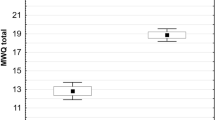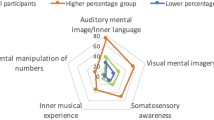Abstract
The default mode network (DMN) is associated with the occurrence of mind-wandering or task-unrelated thought. In contrast, the frontal-parietal network (FPN) and visual network (VS) are involved in tasks with external stimuli. However, it is not clear how these functional network interactions support these two different processes – mind-wandering and on-task – especially with regard to individual variation in the mind-wandering experience. In this study, we investigated the functional connectivity and modular structure among the DMN, FPN, and VS. Our results showed that, compared to the on-task period, mind-wandering was associated with increased DMN activity and increased DMN-VS connectivity. Moreover, mind-wandering was accompanied by a large number of transitional nodes, which expressed a diversity of brain regions. Intriguingly, the functional connectivity of the FPN and VS was strongly correlated with individual behavioral performance. Our findings highlight the individual variation of mind-wandering, which implies the importance of other complementary large-scale brain networks.





Similar content being viewed by others
References
Smallwood J, Schooler JW. The science of mind wandering: empirically navigating the stream of consciousness. Annu Rev Psychol 2015, 66: 487–518.
Song X, Wang X. Mind wandering in Chinese daily lives–an experience sampling study. PLoS One 2012, 7: e44423.
Kane MJ, Brown LH, McVay JC, Silvia PJ, Myin-Germeys I, Kwapil TR. For whom the mind wanders, and when: an experience-sampling study of working memory and executive control in daily life. Psychol Sci 2007, 18: 614–621.
Killingsworth MA, Gilbert DT. A wandering mind is an unhappy mind. Science 2010, 330: 932.
Mason MF, Norton MI, Van Horn JD, Wegner DM, Grafton ST, Macrae CN. Wandering minds: the default network and stimulus-independent thought. Science 2007, 315: 393–395.
Christoff K, Gordon AM, Smallwood J, Smith R, Schooler JW. Experience sampling during fMRI reveals default network and executive system contributions to mind wandering. Proc Natl Acad Sci U S A 2009, 106: 8719–8724.
Fox KC, Spreng RN, Ellamil M, Andrews-Hanna JR, Christoff K. The wandering brain: meta-analysis of functional neuroimaging studies of mind-wandering and related spontaneous thought processes. Neuroimage 2015, 111: 611–621.
Kucyi A, Esterman M, Riley CS, Valera EM. Spontaneous default network activity reflects behavioral variability independent of mind-wandering. Proc Natl Acad Sci U S A 2016, 113: 13899–13904.
Smallwood J, Schooler JW. The restless mind. Psychol Bull 2006, 132: 946–958.
Smallwood J, Beach E, Schooler JW, Handy TC. Going AWOL in the brain: mind wandering reduces cortical analysis of external events. J Cogn Neurosci 2008, 20: 458–469.
Axelrod V, Rees G, Lavidor M, Bar M. Increasing propensity to mind-wander with transcranial direct current stimulation. Proc Natl Acad Sci U S A 2015, 112: 3314–3319.
van Gaal S, Ridderinkhof KR, Scholte HS, Lamme VA. Unconscious activation of the prefrontal no-go network. J Neurosci 2010, 30: 4143–4150.
Smallwood J. Distinguishing how from why the mind wanders: a process-occurrence framework for self-generated mental activity. Psychol Bull 2013, 139: 519–535.
Villena-Gonzalez M, Wang HT, Sormaz M, Mollo G, Margulies DS, Jefferies EA, et al. Individual variation in the propensity for prospective thought is associated with functional integration between visual and retrosplenial cortex. Cortex 2018, 99: 224–234.
McVay JC, Kane MJ. Conducting the train of thought: working memory capacity, goal neglect, and mind wandering in an executive-control task. J Exp Psychol Learn Mem Cogn 2009, 35: 196–204.
Andrews-Hanna JR, Smallwood J, Spreng RN. The default network and self-generated thought: component processes, dynamic control, and clinical relevance. Ann N Y Acad Sci 2014, 1316: 29–52.
Mittner M, Hawkins GE, Boekel W, Forstmann BU. A neural model of mind wandering. Trends Cogn Sci 2016, 20: 570–578.
Seli P, Risko EF, Smilek D, Schacter DL. Mind-wandering with and without intention. Trends Cogn Sci 2016, 20: 605–617.
Andrews-Hanna JR, Kaiser RH, Turner AE, Reineberg AE, Godinez D, Dimidjian S, et al. A penny for your thoughts: dimensions of self-generated thought content and relationships with individual differences in emotional wellbeing. Front Psychol 2013, 4: 900.
Poerio GL, Sormaz M, Wang HT, Margulies D, Jefferies E, Smallwood J. The role of the default mode network in component processes underlying the wandering mind. Soc Cogn Affect Neurosci 2017, 12: 1047–1062.
Wang HT, Poerio G, Murphy C, Bzdok D, Jefferies E, Smallwood J. Dimensions of experience: exploring the heterogeneity of the wandering mind. Psychol Sci 2018, 29: 56–71.
Fornito A, Harrison BJ, Zalesky A, Simons JS. Competitive and cooperative dynamics of large-scale brain functional networks supporting recollection. Proc Natl Acad Sci U S A 2012, 109: 12788–12793.
Bassett DS, Yang M, Wymbs NF, Grafton ST. Learning-induced autonomy of sensorimotor systems. Nat Neurosci 2015, 18: 744–751.
Calhoun VD, Adali T, Pearlson GD, Pekar JJ. A method for making group inferences from functional MRI data using independent component analysis. Human Brain Mapping 2001, 14: 140–151.
Smith SM, Fox PT, Miller KL, Glahn DC, Fox PM, Mackay CE, et al. Correspondence of the brain’s functional architecture during activation and rest. Proc Natl Acad Sci U S A 2009, 106: 13040–13045.
Lei X, Zhao Z, Chen H. Extraversion is encoded by scale-free dynamics of default mode network. Neuroimage 2013, 74: 52–57.
Whitfield-Gabrieli S, Nieto-Castanon A. Conn: a functional connectivity toolbox for correlated and anticorrelated brain networks. Brain Connect 2012, 2: 125–141.
Rubinov M, Sporns O. Weight-conserving characterization of complex functional brain networks. Neuroimage 2011, 56: 2068–2079.
Christoff K, Irving ZC, Fox KC, Spreng RN, Andrews-Hanna JR. Mind-wandering as spontaneous thought: a dynamic framework. Nat Rev Neurosci 2016, 17: 718–731.
Andrews-Hanna JR. The brain’s default network and its adaptive role in internal mentation. Neuroscientist 2012, 18: 251–270.
Kucyi A, Davis KD. Dynamic functional connectivity of the default mode network tracks daydreaming. Neuroimage 2014, 100: 471–480.
Buckner RL, Andrews-Hanna JR, Schacter DL. The brain’s default network: anatomy, function, and relevance to disease. Ann N Y Acad Sci 2008, 1124: 1–38.
Hoffmann F, Banzhaf C, Kanske P, Bermpohl F, Singer T. Where the depressed mind wanders: Self-generated thought patterns as assessed through experience sampling as a state marker of depression. J Affect Disord 2016, 198: 127–134.
Kanske P, Schulze L, Dziobek I, Scheibner H, Roepke S, Singer T. The wandering mind in borderline personality disorder: Instability in self- and other-related thoughts. Psychiatry Res 2016, 242: 302–310.
Strand J, Tidefors I. “If you’re not safe anywhere, you turn it inside yourself”: Narratives about childhood experiences told by 12 individuals diagnosed with psychosis. Psychosis 2012, 4: 137–148.
Perkins AM, Arnone D, Smallwood J, Mobbs D. Thinking too much: self-generated thought as the engine of neuroticism. Trends Cogn Sci 2015, 19: 492–498.
Miller EK. The prefrontal cortex and cognitive control. Nat Rev Neurosci 2000, 1: 59–65.
Goulden N, Khusnulina A, Davis NJ, Bracewell RM, Bokde AL, McNulty JP, et al. The salience network is responsible for switching between the default mode network and the central executive network: replication from DCM. Neuroimage 2014, 99: 180–190.
Dixon ML, Fox KC, Christoff K. A framework for understanding the relationship between externally and internally directed cognition. Neuropsychologia 2014, 62: 321–330.
Phillips RC, Salo T, Carter CS. Distinct neural correlates for attention lapses in patients with schizophrenia and healthy participants. Front Hum Neurosci 2015, 9: 502.
Ruby FJ, Smallwood J, Engen H, Singer T. How self-generated thought shapes mood–the relation between mind-wandering and mood depends on the socio-temporal content of thoughts. PLoS One 2013, 8: e77554.
Stawarczyk D, Cassol H, D’Argembeau A. Phenomenology of future-oriented mind-wandering episodes. Front Psychol 2013, 4: 425.
Karapanagiotidis T, Bernhardt BC, Jefferies E, Smallwood J. Tracking thoughts: Exploring the neural architecture of mental time travel during mind-wandering. Neuroimage 2017, 147: 272–281.
Acknowledgements
This research was supported by grants from the National Natural Science Foundation of China (31571111), the Chongqing Research Program of Basic Research and Frontier Technology (cstc2017jcyjAX0110) and the Fundamental Research Funds for the Central Universities (SWU1609109).
Author information
Authors and Affiliations
Corresponding author
Ethics declarations
Conflict of interest
The authors declare that the research was conducted in the absence of any commercial or financial relationships that could be construed as a potential conflict of interest.
Electronic supplementary material
Below is the link to the electronic supplementary material.
Rights and permissions
About this article
Cite this article
Zhou, X., Lei, X. Wandering Minds with Wandering Brain Networks. Neurosci. Bull. 34, 1017–1028 (2018). https://doi.org/10.1007/s12264-018-0278-7
Received:
Accepted:
Published:
Issue Date:
DOI: https://doi.org/10.1007/s12264-018-0278-7




